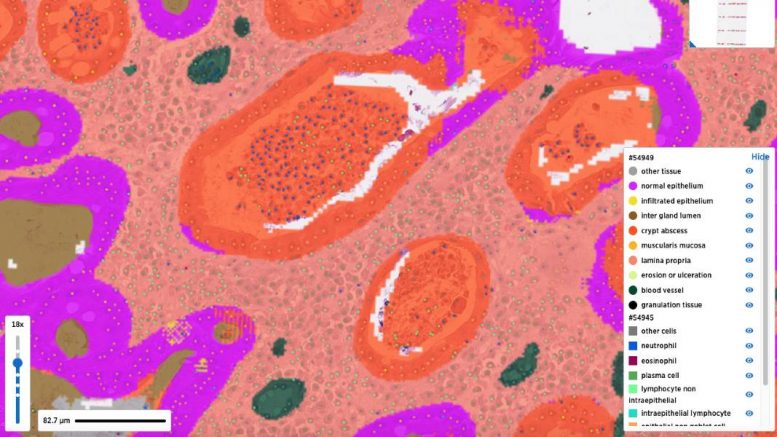PathAI’s IBD Explore™ panel will empower drug developers with improved inflammatory microenvironment spatial characterization from H&E, propelling a new phase of precision medicine in IBD
PathAI, an AI-powered pathology powerhouse, launched IBD Explore, an artificial intelligence-powered panel of human interpretable features (HIFs) offering unprecedented resolution of the inflammatory microenvironment from H&E whole-slide images. IBD Explore uses more than 600 histopathology features to spatially characterize the inflammatory microenvironment, giving drug developers and clinical researchers the ability to unlock insights to inform the next phase of targeted drug development in ulcerative colitis (UC).
According to the Centers for Disease Control (CDC), an increasing number of American adults have faced diagnosis of either UC or Crohn’s disease, known collectively as Inflammatory bowel disease (IBD) over the past two decades. Over the past few decades the global prevalence of UC and Crohn’s disease, known collectively as inflammatory bowel disease (IBD) has increased. A Lancet study found that the prevalence increased from 1990 with 79.5 per 100,000 population with IBD to 84.3 per 100,000 population in 2017. Despite this, remission rates for UC drugs have not surpassed 30% and more than 30% of UC patients stop biologic therapy within 12-18 months due to lack or loss of efficacy.
These observations underscore the need for biomarkers such as histologic signatures to aid in drug development and patient management. Previous research found histologic measures of response to be a better predictor of drug efficacy for relapse-free survival in UC patients than endoscopy alone. IBD Explore allows researchers enhanced histologic visibility, with the ability to structure and analyze spatial measures on a scalable platform, allowing insights to inform future trials.
“IBD Explore provides visibility down to each individual cell in the inflammatory tissue environment and HIFs, and a level of granularity that we’ve never had,” said Andy Beck, M.D., Ph.D., chief executive officer and co-founder of PathAI. “This level of detail helps researchers identify patient subtypes and develop customized therapeutics with the hopes of greater efficacy and increased remission for UC patients.”
In addition to IBD Explore, PathAI also offers automated, AI-powered Geboes scoring with its tool AI Measurement of Histological Index for Ulcerative Colitis, or AIM-HI™UC. Combined, IBD Explore and AIM-HI UC provide IBD drug developers a complete histology solution for translational research and clinical development.
“The utilization of AI-powered pathology has the potential to tremendously benefit researchers in drug discovery and clinical development by reducing trial risk and enhancing therapy differentiation,” said Mike Montalto, Ph.D., chief scientific officer at PathAI. “Our suite of AI-powered solutions can reduce the noise in histological-based endpoints for IBD clinical trials and therefore isolate true drug effect. In collaboration with our biopharma partners, we aim to accelerate precision medicine options for millions of patients with UC.”
To learn more about IBD Explore, visit www.IBDExplore.com

